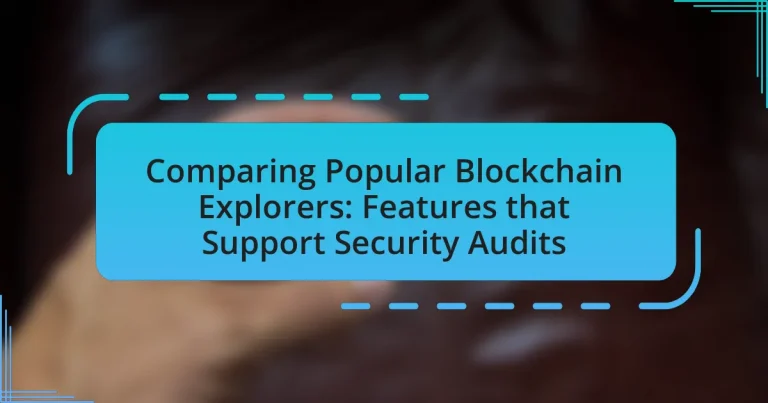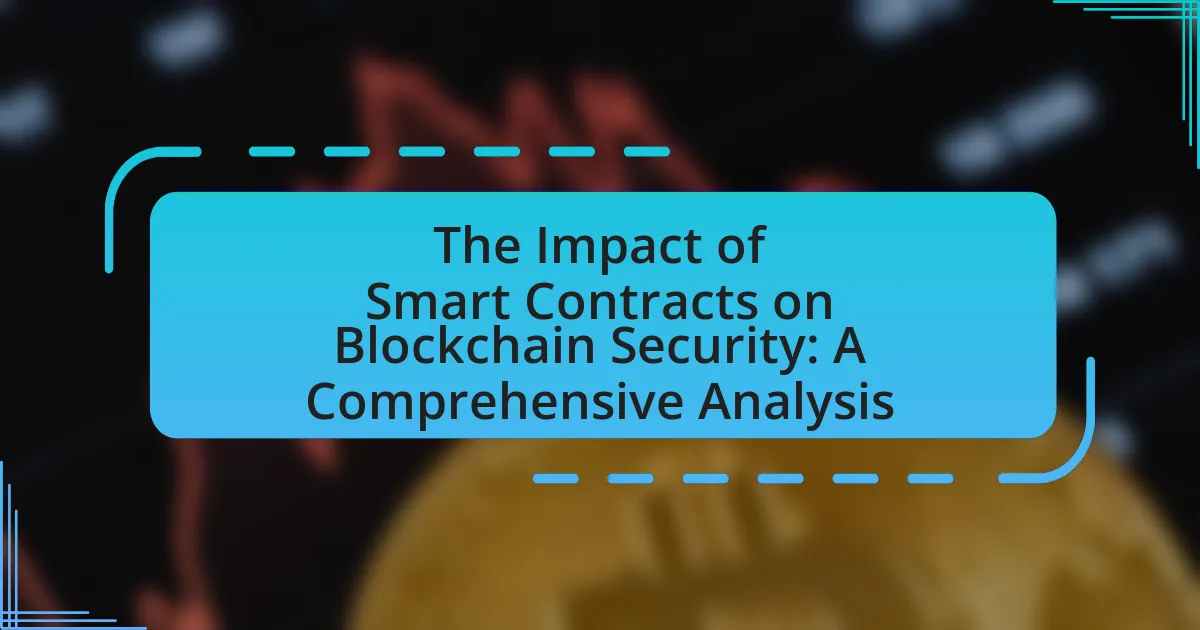Blockchain explorers are essential online tools that enable users to view and analyze blockchain data, playing a critical role in security audits by ensuring transparency and traceability of transactions. This article compares popular blockchain explorers, such as Etherscan and Blockchair, highlighting their key features that support security audits, including transaction tracking, address monitoring, and block verification. It also discusses the importance of evaluating different explorers based on criteria like user interface, data accuracy, and update frequency, while addressing the limitations and challenges users may face when relying solely on these tools for auditing purposes. Additionally, best practices for maximizing the effectiveness of blockchain explorers in security audits are outlined, emphasizing the need for comprehensive analysis and real-time monitoring.
What are Blockchain Explorers and Their Role in Security Audits?
Blockchain explorers are online tools that allow users to view and analyze blockchain data, including transaction histories, block details, and wallet addresses. Their role in security audits is crucial, as they provide transparency and traceability of transactions, enabling auditors to verify the integrity of the blockchain. By examining transaction patterns and identifying anomalies, blockchain explorers help in detecting fraudulent activities and ensuring compliance with security protocols. For instance, explorers like Etherscan and Blockchair offer features that allow auditors to track token movements and assess the legitimacy of transactions, thereby reinforcing the overall security of blockchain networks.
How do Blockchain Explorers function in the context of security audits?
Blockchain explorers function as essential tools in the context of security audits by providing transparent access to blockchain data, enabling auditors to verify transactions and assess the integrity of the blockchain. They allow users to track transaction histories, view block details, and analyze smart contracts, which are critical for identifying anomalies or potential security vulnerabilities. For instance, explorers like Etherscan and Blockchair offer features such as transaction tracing and contract verification, which help auditors ensure that the code behaves as intended and that funds are not misappropriated. This transparency and accessibility of data are vital for maintaining trust and accountability in blockchain systems, as they facilitate thorough examinations of transaction legitimacy and compliance with security protocols.
What key features do Blockchain Explorers provide for security audits?
Blockchain explorers provide several key features for security audits, including transaction tracking, address monitoring, and block verification. Transaction tracking allows auditors to trace the flow of funds through the blockchain, ensuring that all transactions are legitimate and properly recorded. Address monitoring enables the identification of suspicious activities associated with specific addresses, which can help in detecting fraud or unauthorized access. Block verification ensures that the data within each block is accurate and has not been tampered with, providing a reliable source of truth for auditors. These features collectively enhance the transparency and integrity of blockchain transactions, making them essential tools for effective security audits.
How do Blockchain Explorers enhance transparency and traceability?
Blockchain explorers enhance transparency and traceability by providing real-time access to transaction data on a blockchain network. These tools allow users to view transaction histories, wallet balances, and block details, which fosters accountability among participants. For instance, Bitcoin blockchain explorers like Blockchair and Blockchain.com enable users to track the flow of funds, ensuring that all transactions are publicly verifiable and immutable. This transparency is crucial for auditing purposes, as it allows stakeholders to trace the origin and movement of assets, thereby reducing the risk of fraud and enhancing trust in the system.
Why is it important to compare different Blockchain Explorers?
Comparing different Blockchain Explorers is important because it allows users to evaluate the features, accuracy, and reliability of each tool. Different explorers may offer varying levels of detail, user interface design, and transaction tracking capabilities, which can significantly impact the effectiveness of security audits. For instance, some explorers provide real-time data updates while others may have delays, affecting the timeliness of information during audits. Additionally, features such as advanced search options, filtering capabilities, and historical data access can differ, influencing the depth of analysis possible. By comparing these aspects, users can select the most suitable explorer for their specific auditing needs, ensuring comprehensive and accurate assessments of blockchain transactions.
What criteria should be used for comparing Blockchain Explorers?
The criteria for comparing Blockchain Explorers include user interface, supported blockchains, transaction search capabilities, data accuracy, update frequency, and additional features like API access and analytics tools. User interface affects usability, while supported blockchains determine the explorer’s versatility. Transaction search capabilities are essential for efficiency in locating specific transactions, and data accuracy ensures reliable information. Update frequency is crucial for real-time data, and additional features enhance functionality for developers and analysts. These criteria collectively help assess the effectiveness and reliability of Blockchain Explorers in supporting security audits.
How do user experiences vary across different Blockchain Explorers?
User experiences vary across different Blockchain Explorers primarily due to differences in user interface design, data accessibility, and feature sets. For instance, some explorers like Etherscan offer a highly intuitive interface with advanced filtering options, enabling users to easily track transactions and smart contracts, while others may have a more basic layout that complicates navigation. Additionally, explorers such as Blockchair provide multi-blockchain support and customizable search features, enhancing user experience for those dealing with multiple cryptocurrencies. In contrast, less popular explorers may lack comprehensive data or real-time updates, leading to frustration among users seeking timely information. These variations significantly impact how effectively users can interact with blockchain data, influencing their overall satisfaction and efficiency in conducting security audits.
Which Popular Blockchain Explorers are Most Effective for Security Audits?
Etherscan and Blockchair are among the most effective blockchain explorers for security audits. Etherscan provides comprehensive transaction details, contract verification, and a user-friendly interface, making it easier to track and analyze Ethereum-based activities. Blockchair supports multiple blockchains and offers advanced search features, including the ability to filter transactions by various parameters, which enhances the audit process. Both explorers are widely recognized in the blockchain community for their reliability and extensive data, making them essential tools for conducting thorough security audits.
What are the top Blockchain Explorers currently available?
The top blockchain explorers currently available include Etherscan, Blockchair, and Blockchain.com. Etherscan is widely recognized for its comprehensive Ethereum blockchain data, offering features like transaction tracking and smart contract verification. Blockchair supports multiple blockchains, providing advanced search capabilities and analytics. Blockchain.com is known for its user-friendly interface and wallet services, allowing users to explore Bitcoin transactions effectively. These explorers are essential tools for users and developers to monitor blockchain activity and ensure transparency.
How does Explorer A support security audits?
Explorer A supports security audits by providing comprehensive transaction tracking and detailed blockchain analytics. It enables auditors to trace the flow of funds, verify transaction authenticity, and assess the integrity of smart contracts. Additionally, Explorer A offers real-time monitoring of network activity, which helps identify suspicious behavior or anomalies. This functionality is crucial for maintaining transparency and accountability in blockchain operations, thereby reinforcing the overall security framework.
What unique features does Explorer B offer for security audits?
Explorer B offers advanced anomaly detection algorithms specifically designed for security audits. These algorithms analyze transaction patterns in real-time, identifying irregularities that may indicate fraudulent activities. Additionally, Explorer B provides comprehensive reporting tools that allow auditors to generate detailed audit trails, enhancing transparency and accountability. The platform also integrates with various security protocols, ensuring that data integrity is maintained throughout the audit process.
How do these Blockchain Explorers ensure data integrity and security?
Blockchain explorers ensure data integrity and security through the use of cryptographic hashing, decentralized consensus mechanisms, and transparent transaction records. Cryptographic hashing creates a unique digital fingerprint for each block, making it nearly impossible to alter past transactions without detection. Decentralized consensus mechanisms, such as Proof of Work or Proof of Stake, require multiple nodes to validate transactions, ensuring that no single entity can manipulate the data. Additionally, the transparent nature of blockchain allows users to independently verify transactions, further enhancing trust and security. These features collectively contribute to the robustness of data integrity and security in blockchain explorers.
What mechanisms do they use to prevent data tampering?
Blockchain explorers utilize cryptographic hashing, consensus algorithms, and immutability features to prevent data tampering. Cryptographic hashing ensures that any alteration in the data results in a completely different hash, making unauthorized changes easily detectable. Consensus algorithms, such as Proof of Work or Proof of Stake, require agreement among network participants before any changes are accepted, thus preventing malicious alterations. Additionally, the immutability of blockchain records means that once data is added to the chain, it cannot be modified or deleted without consensus from the network, further safeguarding against tampering.
How do they handle user privacy during audits?
They handle user privacy during audits by implementing strict data anonymization protocols. These protocols ensure that any personally identifiable information (PII) is removed or obscured before audit processes begin, thereby protecting user identities. Additionally, many blockchain explorers utilize encryption techniques to secure data during transmission and storage, further safeguarding user privacy. This approach aligns with industry standards for data protection, such as the General Data Protection Regulation (GDPR), which mandates the protection of personal data and privacy for individuals within the European Union.
What are the Limitations of Popular Blockchain Explorers in Security Audits?
Popular blockchain explorers have significant limitations in security audits, primarily due to their inability to provide comprehensive transaction context and real-time monitoring. These explorers typically focus on displaying transaction hashes, block details, and wallet addresses, but they lack advanced analytical tools that can identify suspicious patterns or anomalies in transaction behavior. For instance, while they can show transaction history, they do not analyze the relationships between different addresses or detect potential fraud, which is crucial for effective security audits. Additionally, many explorers do not offer features for tracking off-chain activities or integrating with other security tools, limiting their utility in a holistic security assessment.
What challenges do users face when using Blockchain Explorers for audits?
Users face several challenges when using Blockchain Explorers for audits, primarily related to data complexity and usability. The intricate nature of blockchain data can make it difficult for users to interpret transaction histories and identify relevant information efficiently. Additionally, many Blockchain Explorers lack user-friendly interfaces, which can hinder the auditing process by making navigation cumbersome. Furthermore, the varying levels of detail provided by different explorers can lead to inconsistencies in data interpretation, complicating the audit process. These challenges are compounded by the need for users to possess a certain level of technical knowledge to effectively utilize the tools, which may not be readily available to all auditors.
How do varying levels of blockchain complexity affect audit capabilities?
Varying levels of blockchain complexity significantly impact audit capabilities by influencing the ease of data access, transaction verification, and overall transparency. Simpler blockchains, such as those with fewer transaction types and straightforward consensus mechanisms, allow auditors to quickly analyze data and verify transactions, enhancing efficiency and accuracy in audits. In contrast, more complex blockchains, which may incorporate multiple layers, smart contracts, or intricate consensus algorithms, can obscure data and complicate the audit process, making it challenging for auditors to trace transactions and ensure compliance. For instance, a study by Deloitte highlights that complex blockchain systems can introduce additional risks and require specialized tools for effective auditing, thereby increasing the time and resources needed for thorough audits.
What are the common pitfalls in relying solely on Blockchain Explorers?
Relying solely on Blockchain Explorers can lead to several common pitfalls, including incomplete data interpretation, potential misinformation, and lack of real-time updates. Blockchain Explorers provide a view of transaction data, but they may not capture all contextual information, such as off-chain activities or the implications of smart contract interactions. This limitation can result in misinterpretations of transaction statuses or balances. Additionally, some Blockchain Explorers may not be updated in real-time, leading to outdated information that can misguide users. Furthermore, the reliance on a single Explorer can expose users to biases or inaccuracies inherent in that specific platform, as different Explorers may present data differently or prioritize certain transactions over others.
How can users maximize the effectiveness of Blockchain Explorers for security audits?
Users can maximize the effectiveness of Blockchain Explorers for security audits by utilizing their advanced search functionalities to trace transactions and analyze wallet activities. By inputting specific transaction IDs, wallet addresses, or block numbers, users can gain insights into transaction histories and identify any suspicious activities. Additionally, leveraging features such as real-time alerts for unusual transactions and comprehensive analytics tools can enhance the auditing process. For instance, many Blockchain Explorers provide visual representations of transaction flows, which can help users detect anomalies or patterns indicative of security breaches.
What best practices should be followed when using Blockchain Explorers?
When using Blockchain Explorers, it is essential to verify the authenticity of the blockchain data by cross-referencing multiple explorers to ensure accuracy. This practice is crucial because different explorers may present varying interpretations of the same data due to differences in indexing or data retrieval methods. Additionally, users should familiarize themselves with the specific features of each explorer, such as transaction history, block details, and wallet addresses, to effectively navigate and utilize the information provided. Ensuring the use of reputable and well-established explorers enhances the reliability of the data accessed, as these platforms often implement robust security measures and regular updates.
How can users stay updated on the latest features and improvements?
Users can stay updated on the latest features and improvements by subscribing to official newsletters and following social media channels of the blockchain explorers. Many blockchain explorers regularly publish updates through these platforms, ensuring users receive timely information about new functionalities and enhancements. For instance, platforms like Etherscan and Blockchair maintain active Twitter accounts and blogs where they announce updates, making it easy for users to stay informed.





